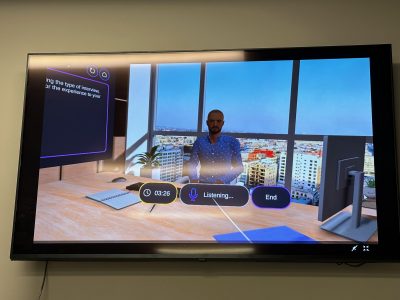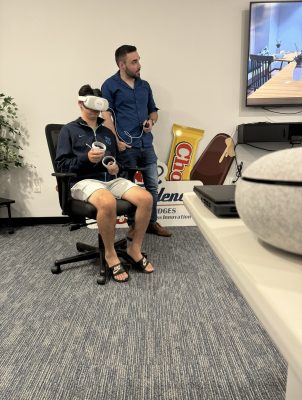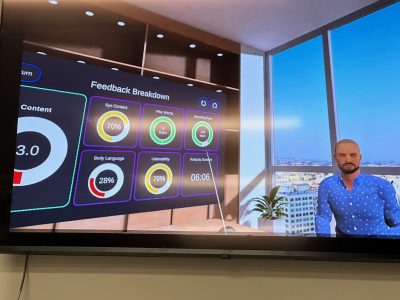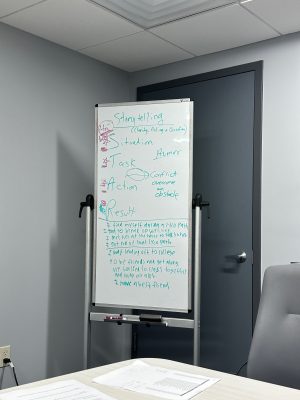Pleasantville Virtual Reality Firm Helps People with Social Challenges Build Skills for Work and Life
News Based on facts, either observed and verified directly by the reporter, or reported and verified from knowledgeable sources.

By Tessa Wheeler
A man sits at a desk, the contrast of his dark polka-dot shirt stark against the light wood desk before him. In the windows behind him, a sprawl of buildings interrupts the expanse of the blue sky. The man stares, and when his mouth moves, it’s not fully in sync with the words he says.
“Hi, C.J.,” the man says. “Thanks for joining today.”
Rob is the man’s name. However, he’s not actually a man. Rob is an AI avatar, created by the UK company VirtualSpeech for its soft-skills training software. Today, he’s in a virtual conversation with C.J. O’Brien, chief executive officer of O’Brien CMC (Creating Meaningful Careers).
O’Brien, standing in his office in Pleasantville, wears a Meta virtual reality headset, so the interaction appears in front of him. Onlookers can witness the virtual conversation from O’Brien’s eyes on a TV mounted on the wall.
Rob pauses before his slightly robotic voice sounds again.
“What kind of interview would you like?”
The Pandemic Inspires Innovation

In 2022, C.J. O’Brien was having a “tough time.” He was working as a vocational rehabilitationist, collaborating with people with disabilities to solidify their social and practical skills for employment, but struggling to implement teachings efficiently over Zoom.
“This is a service that should, probably, all the time be in person,” O’Brien said.
He found that often, people he worked with would lose focus over Zoom, the barrier of physical distance and the downsides of virtual learning becoming another hurdle in the process of gaining vocational skills.
Mark Benitez, O’Brien CMC’s chief operating officer, found himself similarly stuck at the time.
“As an [Applied Behavior Analysis (ABA)] therapist, a lot of things I was doing for a lot of my clients was just role-playing—continuously doing role plays,” he said. “In a way, it’s kind of awkward because, like, they know who I am.”
“There’s gotta be a different way,” O’Brien remembered thinking. “There’s gotta be a cool way.”
A yearslong virtual reality (VR) enthusiast, O’Brien began searching online for new vocational rehabilitation technology powered by VR software. He found some companies offering what he was looking for in the UK and Canada, but none in Westchester. So O’Brien took a break from work and spent six months trying to build a platform of his own, where it would be accessible to those he’d worked to help.
Although he quickly “learned the hard way” that he wasn’t able to code his own software, he encountered VirtualSpeech soon after, and the company was willing to work with him over time to adjust its software to his requirements.
Eventually, the team at O’Brien CMC grew to include Benitez, who had experience as a community habilitation worker, an occupational therapy assistant and ABA therapist, as well as Luis Barros and Angelica Dones as VR instructors. In 2023, the company worked with its first client.
Step by Step
Now, O’Brien CMC offers VR sessions for a variety of skills training. Most of their clients—mainly autistic men in their 20s and 30s—are looking to polish their communication skills ahead of job interviews. Others want to become better storytellers, prepare for management roles, practice dating skills or learn how to drive.
O’Brien says his clients are “very, very, independent guys” who only need “a little bit of help with” what he calls “upskilling.”
“They have goals,” he said. “We’re here to give these guys a new tool to help them learn how to make friends, learn how to excel in their jobs, learn how to get a job in the first place.”
Once clients put on the VR headset, they’re transported to the setting of their specific scenario. If they’re working on an interview, they’ll be placed in an office. If they’re on a date, they’ll appear at a coffee shop or a bar. If driving—then a car.

The AI is prompted for the situation it’s teaching. When O’Brien showed an Examiner reporter how the technology worked, he demonstrated an interview with the AI avatar Rob and prompted him.
“Rob, I have an interview coming up on Friday. It’s for a software engineer role for MetLife, the insurance company, and I’m really excited for it,” O’Brien spoke to the VR headset. “Can you ask me questions related to working at MetLife as a software engineer?”
Rob then proceeded to ask O’Brien myriad questions—ranging from his background in software engineering to pointed, detailed questions about specific projects O’Brien had mentioned in his responses.
At the end of the mock interview, the AI provided feedback to O’Brien on his answers, urging specificity in his responses but complimenting his demeanor and expressed experience. The AI also provided O’Brien with number scores for his performance in each category—something O’Brien says can be motivating for clients who like having those numbers to compare against.

O’Brien and Benitez also teach the S.T.A.R. method in their classes—a storytelling acronym that stands for Situation, Task, Action and Results. It provides scaffolding to conversations, bookending an otherwise unmoored anecdote with intention and explanation for the listener. After the VR sessions end and the AI gives its feedback, O’Brien and Benitez will talk to the client, ask how they think they implemented the S.T.A.R. method, and practice it further. They’ll then do non-VR exercises—sometimes improv—to improve the skills before the session ends.
While person-to-person communication is an integral part of the work at their company, O’Brien and Benitez can’t emphasize enough the importance the VR software holds in their work.
“[Our clients] can talk to this AI that has like, unlimited patience, lots of positive feedback,” O’Brien said, “and they can say whatever they want.”
The AI will “always say something nice based on what you say,” he added, and in doing that demonstrates active listening skills.
Part of the allure of practicing social skills through VR, O’Brien and Benitez say, is the lack of pressure.
“A lot of these guys get into bad cycles—a feedback loop,” O’Brien said. “They have a hard time making friends. They do the wrong thing. They get the negative and it feeds.”
If a first in-person interaction goes wrong, Benitez said, some people “hold onto it forever.”
But with the AI, he said, there are “less consequences.”
“It’s a great safe environment for them to be in,” Benitez said. “It’s a great safe place for them to make these mistakes.”
Science Says So
Scientific studies in recent years have shown the benefits of VR for autistic individuals. Most studies focus on children and adolescents but note improved acquisition time for skills in emotional training, in which autistic individuals work on improving their facial recognition of emotions. Other studies have focused on the use of VR technology to generate inclusive workplaces with support for neurodiverse employees.
The Equitable Learning Technology Lab at the University of Florida observed significant changes in the demeanors of autistic participants using VR, noting an instance where one nonverbal student put on a VR headset and began speaking in complete sentences while using it.
Ethan Anderson, a student who was involved in the University of Florida lab, said “it challenges us and makes us feel powerful.”
As of 2024, only 22.7 percent of people with disabilities in the U.S. were employed. As a vocational counselor, O’Brien cares about this number.
“How can we double that to 40 percent?” he asked. “I’m not going to force you to talk if that’s not coming to you naturally because of the disability. What’s another way you can show the world what you do?”
“I always thought this technology was like, for some of these guys, the best revenge,” he said. “I always saw this technology as being their way of conveying to the world, ‘I can do the job, watch me.’”

Examiner Media – Keeping you informed with professionally-reported local news, features, and sports coverage.
